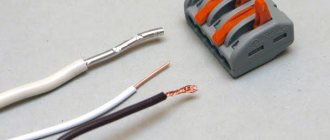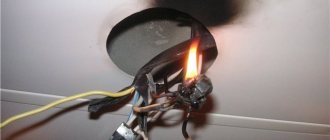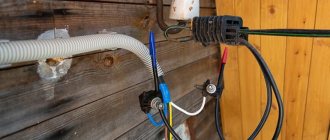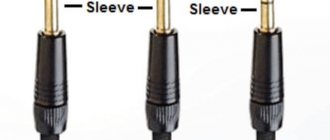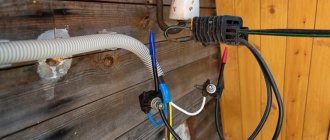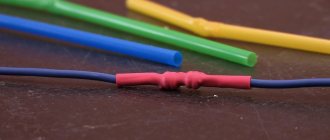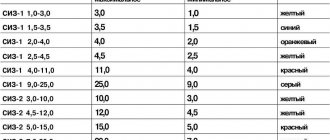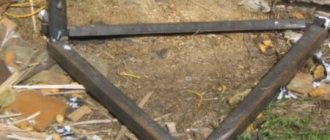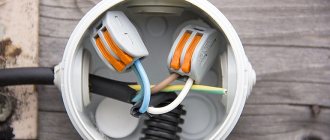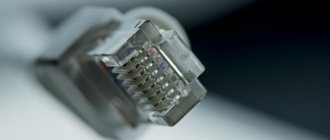Although, by modern standards, wiring in residential apartments is made primarily of copper wires, you can often find electrical wiring made of aluminum. If it is impossible to replace the old wiring with a new one, then you need to learn how to connect aluminum wires with your own hands. So, for example, how to connect a chandelier, socket and other electrical appliances correctly? Is it possible to connect aluminum wires with others? How to make the connection reliable? How to firmly connect aluminum wires to each other? You can get answers to these questions in this article.
Feature of aluminum wire
Features of aluminum
Due to its special characteristics, aluminum is difficult to work with. Also, during the oxidation of this metal, an oxide film is formed on the surface. This, in turn, prevents the good flow of current. This film melts at a temperature of two thousand degrees, and this figure is higher than the melting point of aluminum itself. If you peel off the film mechanically, then literally in a short period of time it appears again. As a result, the oxide film prevents high-quality contact of the connection.
Other features of aluminum include an increased degree of brittleness and fluidity. Based on this, the contact should not be subject to any mechanical stress. For example, if the connection is made using a bolt, then it must be constantly tightened from time to time. This is due to the fact that the aluminum will leak out from under the contact over time.
Welding method
Welding provides the best electrical contact. Due to the homogeneity of the resulting connection, there is no problem of increased resistance of the circuit section.
A welding machine is used with an output power of up to 1 kW and an adjustable voltage within the range of 14-20 V. Welding is considered successful if a drop has formed at the end of the twist, with a diameter approximately equal to the twist.
When welding, a carbon conductor is used along the end of the twist. The exposure time should not exceed 2 seconds.
There is an option for gas welding of wires. In an inert gas atmosphere, the oxide film ceases to form, which significantly facilitates the process, but specific knowledge and equipment are required.
Electrochemical corrosion
Is it possible to connect aluminum wire with others? Yes! But here it is important to take into account some important points. If there is no moisture, then such a connection will be eternal. However, moisture is present everywhere, which in turn contributes to the destruction of contacts. It is also important to take into account the fact that each electrical conductor has its own electrochemical potential. In this regard, accumulators and batteries were created, however, when water enters the junction of metals, a short-circuited galvanic cell is formed. As a result, one of the metals is destroyed. To find out which metals can be connected and which cannot, it is important to know the value of the electrochemical potential of a particular current conductor.
Factors of galvanic corrosion
For example, it is permissible to connect different wires if the level of electrochemical potential between them does not exceed 0.6 mV. Based on this, it turns out that the connection of copper with stainless steel will be of high quality with a potential difference of 0.1 mV, in contrast to the connection with silver (0.25 mV) or gold (0.4 mV).
Note!
If the copper wire is coated with tin-lead solder, then any mechanical connection to the aluminum wire is allowed.
Twist
Electrochemical corrosion possible
This is one of the easy methods for connecting wires. In this case, absolutely no qualifications or special knowledge are required. But the result is a far from reliable connection. Why? Everything is due to the fact that during the period of temperature fluctuations, a linear expansion of the wires occurs and, as a result, a gap forms between them, which in turn increases the resistance. Afterwards, the contact oxidizes and after some time is destroyed.
Note!
This will not happen in the first year. But if you want to create a reliable and high-quality connection, then you should think about a more reliable alternative.
How is such a connection made? It is important here that one wire does not wrap around the other, but that they both wrap around each other. To ensure a high-quality connection, the copper wire can be tinned with solder. There is no restriction on the diameter of the connected wires. If the copper wire is stranded, then it must be tinned with solder. If the wire is thick, then three turns will be enough, and on a thin wire up to Ø1 mm, five turns must be made.
Twisting methods
Soldering method
Before tinning the surface, the oxide film is removed. This can be done either by mechanical force, for example, sandpaper or a brush with metal bristles, or by using a special chemical - flux. It is a white powder that dissolves in water and is then applied to the ends of the tinned wires.
Aluminum oxidation in air occurs in a matter of seconds, so mechanical action alone cannot remove oxides. It is recommended to combine the use of flux and surface cleaning.
If two wires are being soldered, using a 60 W soldering iron will be sufficient. For wires with a large cross-section and when soldering multi-core twists, you will need a soldering iron with a power of 150 W or more.
The tin content in the solder must be at least 50%. You can take solder with 60-90% content.
Soldering aluminum step by step:
- Degrease the surface. Gasoline and alcohol will do. This will thin the oxide film.
- Fix the wire strands in the required position.
- Apply flux. Make sure it hits the cable joint.
- Warm up the twisting area with a soldering iron or gas torch. In the latter case, you should be careful, as the metal heats up quickly and can melt.
- Tin the connection point. Gently rub the solder with a soldering iron until a homogeneous shiny film appears.
A properly treated surface acquires a characteristic metallic sheen. Sagging and untinned areas should not be allowed to appear.
Tin solder is susceptible to corrosion, so the finished connection is treated with varnish.
When extending wires, if operation is expected in difficult conditions, a soldered or welded connection will perform best. In everyday life, for cables that are not subject to mechanical stress, crimping with a sleeve is quite suitable.
Threaded connection
Bolted
One of the most reliable options for connecting aluminum and copper wires using nuts and screws. Such connections will ensure high-quality contact for many years. This method can be used to connect wires of different sections, stranded and single-core.
So, first you need to remove the insulation from the end of the wire. Then a spring washer, a regular washer, a ring of one conductor, a simple washer, a ring of another conductor, a washer and finally a nut are put on the screw, which tightens the entire structure.
Note!
If the conductor has a Ø2 mm core, then the screw should be M4.
If the wire is stranded, then it should first be tinned with solder.
Pressing method
Pressing is done using a special sleeve into which the cores are inserted, after which they are crimped with a special tool - a crimper. Sleeves vary in diameter, length and material. When installing the cable, only aluminum or brass sleeves must be used. Using brass elements, you can connect both aluminum to aluminum and copper to aluminum wires.
When connecting aluminum conductors, copper-containing sleeves must not be used. These two metals form a galvanic couple, which leads to accelerated destruction of aluminum.
To connect cores with different sections, special sleeves with different diameters of inlet holes are used.
The correct choice of sleeve diameter will protect the chain section from overheating. A larger diameter will give a small contact patch and increased resistance. If the cross-section of the sleeve is smaller, it is necessary to reduce the cross-section of the cores, which will also negatively affect the conductive properties.
Terminal block
Terminal block
Terminal block is another modern method of connecting aluminum and copper wires. Although it is very popular, the screw and bolt connection method is much more reliable. However, the terminal block allows you to quickly and efficiently connect wires. In this case, there is no need to form rings at the end of the wire, or additional insulation. This design completely eliminates the possibility of contact between two bare wires.
This connection is made as follows: The end of the wire is stripped of insulation to a length of up to 5 mm. Afterwards, a wire is inserted into the hole in the terminal block and tightened with a screw.
Note!
The screw should be tightened with sensitivity, especially with aluminum wire.
This connection is very helpful in cases where a short piece of aluminum wire sticks out from the ceiling. If in this case you use the twisting method, then sooner or later the wire will simply break off. The same cannot be said for using a terminal block. Also, if aluminum wires were accidentally broken in the wall, then this technology simplifies their connection. But there is one thing! The terminal block cannot be hidden in plaster or in the wall without a special distribution box.
How to connect
There are several options for the correct and absolutely safe connection of aluminum conductor cores. They differ in labor intensity and level of complexity, so in each specific case the connection method should be individually selected.
Soldering
One of the most reliable connection methods, based on the mechanical removal of formed natural oxides and the simultaneous application of soldering acid to the cleaned areas.
For soldering you need to purchase special solder
- Carefully strip the core from the insulating layer by 40–50 mm.
- Sand the bare ends with fine-grit sandpaper and twist them together.
- Repeated processing of the resulting twist with sandpaper.
- Application of soldering acid to the twist, which prevents the formation of an oxide film.
- Filling the twist grooves with well-molten solder.
- Treatment of joint areas with alkali and rinsing in water to remove acid residues.
The dried joint is treated with waterproof varnish, after which it is insulated with cambrics, caps or regular electrical tape.
Clamp connection (terminal)
The most common connection method. Compression involves the use of a bolt, screw or clamping spring connection method. It is optimal to use special Wago terminals.
Special terminals are often used to connect wires
Wago terminal connection technology:
- Remove the insulating layer from the ends of the wires to a length of 10 mm.
- Insert the bare ends into the round holes of the self-clamping type contacts.
- Press the moving zone or lift the terminal lever.
- Having advanced the wire, release the moving part or lock the lever in the lower position.
Terminal block and spring clamp
Block with clamp
This method of connecting wires appeared relatively recently. There are two types: disposable and reusable. In the latter case, there is a special lever that allows you to remove and insert the wire several times. Such terminal blocks allow you to connect stranded wires of different types of aluminum with copper wires.
They are widely used for mounting chandeliers, as well as for connecting wires in junction boxes. The wire is inserted into the hole of the block with force and is securely fixed there. It will take a lot of effort to remove the wire. In practice, it is better to use reusable terminal blocks, which allow you to redo the connection in case of a miscalculation.
10 mm of insulation is removed from the wire. The lever on the reusable terminal block rises up and the wire is inserted. Then the lever returns to the reverse position. The connection is ready!
Compression method
When routing cables in a distribution box, accidental contact of adjacent wires is highly undesirable. Terminal blocks are used for this purpose.
The terminal is an insulated sleeve into which the conductors are inserted. Internally, either a screw or a spring is used for fixation.
If you intend to install a stranded wire, before installing it into the terminal it is necessary to crimp it with a special sleeve, which will improve contact and reduce the likelihood of pinching.
When using terminals with a screw connection, you need to clearly control the clamping force in order to avoid cutting the wire with a screw and its subsequent destruction. Wago terminal blocks do not have this drawback. In them, the mechanism for fixing the core is a brass plate and a spring. The use of brass in the composition makes it possible to safely connect cables made of different metals.
Permanent connection
This type of connection has almost all the advantages of a threaded connection. You can highlight the speed of installation, durability, affordable price and ease of connection. The principle of its operation is simple. To connect the wire with a rivet, rings with a diameter of 4 mm are prepared. First put on the aluminum wire, then the spring washer, copper wire and flat washer. A steel rod is inserted into the rivet gun and compressed until the handle clicks. As a result, the excess conductor is cut off and the connection is completely ready.
The reliability of such a connection is very high. It is used for splicing wires. The most important requirement when using it is insulation of the connection area.
Lubrication
To improve the quality of contact, you can use a special lubricant or paste. Usually this is quartz vaseline paste. It is usually used to improve the connection of aluminum wires.
But this paste can be used for all types of connections (threaded, using terminal blocks, crimping), especially if the connection takes place outdoors. Then the contact is affected by additional factors that significantly reduce the durability of the connection. Although the use of lubricant without insulation raises doubts.
Based on all of the above, select the method that is suitable for you, depending on the location of the connection (street, house) and material capabilities.
Twisting aluminum wires together
Parallel twist
We talked about the advantages and features of twisting above, but now we will consider this issue from a different angle, namely, connecting an aluminum wire with a similar one. In this case, the success of using the twisting method will directly depend on the cross-section, diameter of the wires and other important factors. Ideally, aluminum wires are best soldered by first twisting them with a groove.
- Parallel twist.
- Sequential twisting.
Serial twisting
However, it is important to be careful here, since an oxide film forms on the surface of aluminum wires. Even if you clean it, it will reappear very quickly, as noted above, so the ends of the wire can be cleaned with a file until shiny or with sandpaper. It is recommended to compress the lowest turn with pliers. Such a connection will be durable and strong.
Working with a soldering iron
In order to solder aluminum with a soldering iron, there are several methods, the essence of which is to clean immediately under the flux layer in direct contact with the molten solder.
The first method is that aluminum conductors, before soldering, are cleaned with a hot tinned soldering iron using a mixture of rosin and steel filings.
Sawdust has an abrasive effect, rosin removes all impurities and immediately the cleaned areas are covered with solder, which should be on the soldering iron tip.
The second method involves stripping the aluminum wire on medium-grit sandpaper directly under the influence of a hot soldering iron with solder and flux.
Useful tips and tricks
Each wire connection must be properly insulated.
It is recommended to place them in junction boxes. If such a connection is simply plastered in the wall, then access to it is limited and, accordingly, it will be impossible to tighten the contacts. Although if you use spring clamp technology, this will not be necessary.
Connecting wires in the distribution box
If you want to make such a connection with your own hands at home, it is not recommended to use soldering or welding wires if you have no experience in performing such work. The best option would be a contact clamp or one of the methods described above for connecting aluminum wire to copper or to each other.
So, we have reviewed with you the most common methods of connecting aluminum wire. Of course, if you have no experience or are simply afraid to take on such work, then it is better not to risk it and turn to a specialist. Otherwise, if you have experience with such work, proceed by following all the recommendations in this article.
